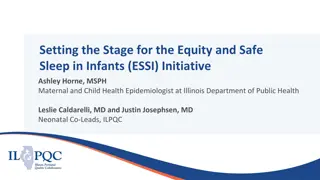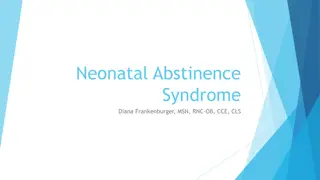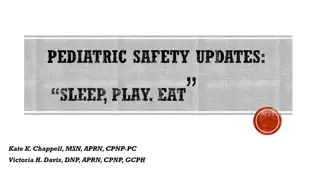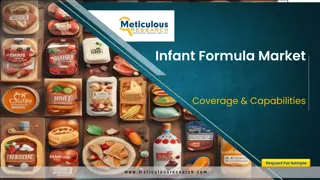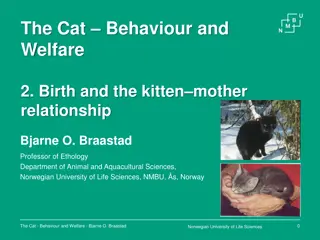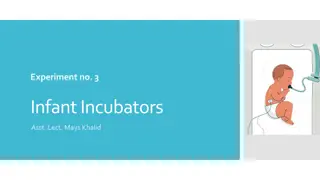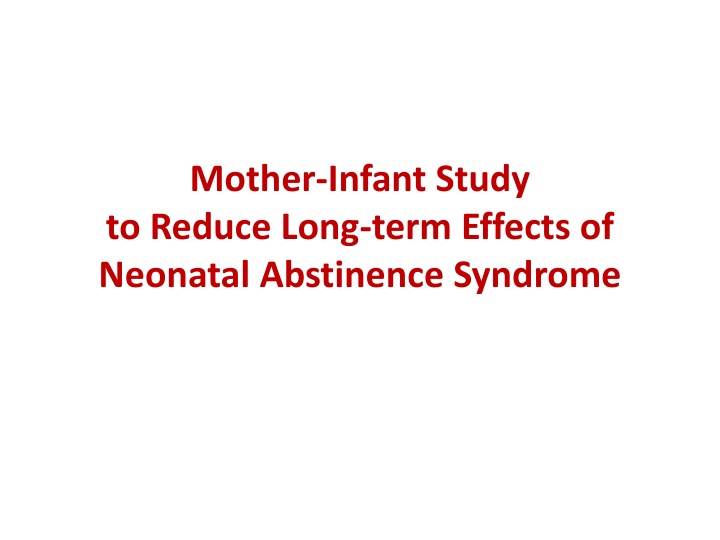
Reducing Long-Term Effects of Neonatal Abstinence Syndrome through Innovative Mother-Infant Study
Discover how a comprehensive study aims to reduce the long-term effects of Neonatal Abstinence Syndrome (NAS) through a tailored WeCare program in Indiana. The project overview focuses on reducing infant mortality rates and promoting maternal and infant health across different demographics by addressing key risk factors and providing tailored health education, coaching, and community health worker support.
Download Presentation

Please find below an Image/Link to download the presentation.
The content on the website is provided AS IS for your information and personal use only. It may not be sold, licensed, or shared on other websites without obtaining consent from the author. If you encounter any issues during the download, it is possible that the publisher has removed the file from their server.
You are allowed to download the files provided on this website for personal or commercial use, subject to the condition that they are used lawfully. All files are the property of their respective owners.
The content on the website is provided AS IS for your information and personal use only. It may not be sold, licensed, or shared on other websites without obtaining consent from the author.
E N D
Presentation Transcript
Mother-Infant Study to Reduce Long-term Effects of Neonatal Abstinence Syndrome
NAS Infants 2012-2016 (Eskenazi and Methodist NICUs) 159 144 126 114 96 80 76 76 48 44 38 38 34 33 32 2102 2013 2104 2015 2016 Eskenazi Methodist All
Cohort Study 1 Implementation Study 2 Randomized Control Study 3
Overview WeCare Indiana and plan for adaptation for working with an NAS population RCT of mother-child NAS dyads involving 2 arms: WeCare and Circle of Security Data elements to allow both retrospective and prospective analysis of RCT dyads: descriptive study and enriched follow up data
WeCare Indiana: Improving Maternal and Infant Health to Reduce Infant Mortality PI: Deb Litzelman
Project Overview Reduce infant mortality across all races and SES groups in Marion and Delaware Counties Partner with community organizations to co-develop, document and evaluate strategies that support maternal healthy life-course and infant health ImplementWeCare Indiana program, with health coaches and tailored mHealth messages Focus on high priority risk factors for infant mortality Maternal Health Factors Smoking Mental Health: substance use (prescription drugs, illicits), alcohol, depression, anxiety Obesity/Nutrition: food insecurity, lifestyle, diet, exercise Infant Health Factors Safe Sleep Breastfeeding Evaluate effectiveness Disseminate findings
Tailored Health Education Health Coaching Community Health Workers Carefully selected from the local community Tailored mHealth educational messaging For the 5 targeted indicators Social Determinants of Health: The Basics (food, housing, heat) Bi-directional secure messaging system; dashboard for data capture
Y1 Study Participants: Demographics ODHS N=120 (%) RHC N=117 (%) Total N=238 (%) Campaign Pregnant 108 (90) 101 (86) 209 (88) Postpartum 11 (9) 13 (11) 24 (10) Childbearing Age 1 (1) 4 (3) 5 (2) Age < 18 6 4 10 (4) 18-25 61 46 107 (45) 26-30 26 32 58 (24) 31-35 15 20 35 (15) > 35 10 5 15 (6) Race White 91 (76) 13 (11) 104 (44) Black 19 (16) 95 (81) 114 (48) Other 10 (8) 10 (8) 20 (8)
Process Measures Screening for Risk Factors/Establish Prevalence Smoking Mental Health: Depression, anxiety, substance abuse Nutrition: Diet, exercise, lifestyle habits Safe sleep practices Breastfeeding The Basics Educational Interventions # of SMS messages sent # of coaching sessions
Y1 Preliminary Outcomes: Improved Health Behaviors Smoking reduction/cessation (5%) Substance Abuse*-reduction/cessation (77%) Mental Health-PHQ-9/GAD-7 improved (30%) Nutrition-fewer skipped meals in last week (33%) Safe Sleep-more sleeping alone on back (20%) Breastfeeding-continued for > 3 months (80%) * Note: a very small number of patients screened positive for SA
WeCare Plus: An Innovative, Community-Based, Collaborative Initiative to Decrease Infant Mortality Indiana State Department of Health s SafetyPIN Initiative 1 of 10 funded $2.1 M awarded with focus on Central Region Expand to include other FQHCs in Marion County: ESKENAZI COMMUNITY HEALTH CENTERS (11) HEALTHNET CLINICS (4) SHEPHERD COMMUNITY HEALTH CENTER (1) RAPHAEL HEALTH CENTER (1)
Care Plus: An Innovative, Community- based Addiction Reduction plus Policy Innovations Program for Indiana Background and Rationale for Study: Care Plus is planned as a partnership of healthcare, public, and community organizations, designed to reduce Opiate mortality and addiction in Indiana, beginning with pilot implementation in three counties (Marion, Delaware, and one other southern Indiana county) through outreach, health coaching, community engagement, and mobile health (mHealth) messaging technology.
Specific Aim One Care Plus CHW coaches training and clinical decision and SMS messaging support tools will be expanded to include a more comprehensive screening, care, and resource tool kit for clients with opioid and illicit drug use.
Specific Aim Two On-going in-services will be provided to NICU staff about the Care Plus program to link mothers and fathers of children born with NAS with Care Plus CHW in non-urgent situations to assist with appropriate treatment plans and referrals and on-going recovery coaching.
Specific Aim Three First Responders will be trained using materials similar to CarePlus CHW education materials and will help screen and link community members using opioid and illicit drugs with CHW in non-urgent situations to assist in appropriate treatment plans and referrals and on-going recovery coaching.
Specific Aim Four Develop human-centered monitoring and evaluation programs to conduct detailed root cause analyses of high opiate morbidity/ mortality communities and develop community-driven solutions to address their opiate abuse challenges.
Mother-Infant Study to reduce long term effects of Neonatal Abstinence Syndrome
Cohort Study 1 Implementation Study 2 Randomized Control Study 3
Cohort Parent-Infant pairs: neonates born with NAS 1. Demographics 2. Birth history (vag/CS/Pitocin) 3. Infant data: gestational age/weight/APGARS 3. Psychiatric history (including SA history) 4. Adverse Childhood Experiences 5. Attachment Security of parents 6. Paternal involvement
Implementation Study Implementation of WeCare Plus in an NAS population CHW training CHW involvement with parents (personal contact/SMS) Connection to treaters Implementation of Circle of Security in an NAS population CHW trained In hospital/outpatient follow-up in home
Randomized Control Study 50% of parents of NAS infants will participate in Circle of Security. 50% of parents of NAS infants will not participate in Circle of Security.
Neonates All NAS Babies enrolled: Access to care for moms Treatment for babies Cortisol (Saliva) Oxytocin (Saliva) Vasopressin (Saliva) Genetic Testing (Saliva) WeCare Randomized 50%: Circle of Security
Outcomes Parental participation in MAT Nicotine/drug/alcohol use Breastfeeding Rooming with infant Parental presence Skin-to-skin contact (hours) Reliance on CHW for support (SMS, contact) Depression/Anxiety (rating scales) Parental Reflective functioning Total amount of opiate used in infant Discharge plans: home/foster Length of Stay Neurocognitive Development at 12 months Mortality at 12 months
Supplemental data for RCT cohort Leverage existing data for 2 objectives: Description of the pathways (correlates) of opioid- addicted pregnant women Enhanced description of near- and longer-term correlates and outcomes as they relate to both mother and baby child adolescent Women in RCT consented for linkage with specified sources Add expanded longitudinal view of these dyads both before and (long) after recruitment
Cohort Study 1 Implementation Study 2 Randomized Control Study 3
Socio-ecological data elements Organizational (healthcare, schools, workplaces, justice agencies, social services) Interpersonal (family, friends, networks) Individual (mother- child dyad)
Level Domain Data element Proposed Source gender race/ethnicity age marital status education income occupation (employment status) household size number of children % below FPL % incarcerated % with high school diploma % single parent households with children, etc. preventive care encounters urgent care/ED/inpatient encounters EMS utilization medications (including naloxone administration, suboxone, methadone, etc) diagnoses (including MH, other substance use, chronic conditions inducing pain, etc.) procedures treatment (MH-related visits, inpatient rehab, etc.) test/test results witness/victim of crime arrest MPH MPH MPH MPH MPH MPH MPH MPH MPH Census, SAVI (from MPH residence) Census, SAVI (from MPH residence) Census, SAVI (from MPH residence) Demographic Individual Socioeconomic Household characteristics Interpersonal Measures/Data Neighborhood characteristics Census, SAVI (from MPH residence) Mothers INPC/Medicaid INPC/Medicaid Indy EMS Clinical care utilization INPC/Medicaid/Indy EMS/INSPECT INPC/Medicaid Clinical condition Organizational INPC/Medicaid INPC/Medicaid INPC/Medicaid Marion County Prosecutor's Office Marion County Courts Marion County Courts/Marion County Sheriff's Office Indiana DOC Quest (Indiana Supreme Court) MPH MPH MPH MPH Justice interactions jail stay prison stay juvenile detention WIC Food stamps unemployment Section 8 Social service utilization
Level Domain Data element Proposed Source gender race/ethnicity age maternal education household income household employment status household size number of children % below FPL % incarcerated % with high school diploma % single parent households with children, etc. delivery history birthweight, gestational age, apgars hospital LOS Finnegan scores breastfeeding discharge location (home, kinship care, foster care) preventive care encounters urgent care/ED/inpatient encounters EMS utilization diagnoses (including developmental delay, behavioral conditions, etc.) medications procedures test/test results Age/nature of DCS case/status WIC Disability Food stamps (family) unemployment (family) Section 8 housing (family) CCDF (daycare) MPH MPH MPH MPH MPH MPH MPH MPH Census, SAVI (from MPH residence) Census, SAVI (from MPH residence) Census, SAVI (from MPH residence) Demographic Individual Socioeconomic Household characteristics Interpersonal Measures/Data Neighborhood characteristics Census, SAVI (from MPH residence) clinical records clinical records clinical records clinical records clinical records Infants Birth history clinical records INPC/Medicaid INPC/Medicaid Indy EMS Clinical care utilization Organizational INPC/Medicaid Clinical condition INPC/Medicaid INPC/Medicaid INPC/Medicaid MPH MPH DCS involvement MPH MPH MPH MPH Social service utilization
Level Domain Data element Proposed Source gender race/ethnicity age maternal education household income household employment status household size number of children % below FPL % incarcerated % with high school diploma % single parent households with children, etc. preventive care encounters urgent care/ED/inpatient encounters EMS utilization diagnoses (including developmental delay, ADHD or other behavioral conditions, MH, etc.) treatment (related to behavioral/MH, substance use, etc.) medications procedures test/test results school performance special services (IEP, 504, etc.) ISTEP/test scores missed days Age/nature of DCS case/status WIC Disability Food stamps (family) unemployment (family) Section 8 housing (family) CCDF (daycare) MPH MPH MPH MPH MPH MPH MPH MPH Census, SAVI (from MPH residence) Census, SAVI (from MPH residence) Census, SAVI (from MPH residence) Demographic Individual Socioeconomic Household characteristics Interpersonal Measures/Data Young Children Neighborhood characteristics Census, SAVI (from MPH residence) INPC/Medicaid INPC/Medicaid Indy EMS Clinical care utilization INPC/Medicaid Clinical condition INPC/Medicaid INPC/Medicaid INPC/Medicaid INPC/Medicaid MPH? MPH? MPH? MPH? MPH MPH Organizational School DCS involvement MPH MPH MPH MPH Social service utilization
Level Domain Data element Proposed Source gender race/ethnicity age maternal education household income household employment status household size number of children % below FPL % incarcerated % with high school diploma % single parent households with children, etc. preventive care encounters urgent care/ED/inpatient encounters EMS utilization diagnoses (including developmental delay, ADHD or other behavioral conditions, MH, substance use as older child/adolescent, etc.) treatment (related to behavioral/MH, substance use, etc.) medications procedures test/test results school performance special services (IEP, 504, etc.) ISTEP/test scores Missed days Age/nature of DCS case/status witness/victim of crime arrest MPH MPH MPH MPH MPH MPH MPH MPH Census, SAVI (from MPH residence) Census, SAVI (from MPH residence) Census, SAVI (from MPH residence) Demographic Individual Older Children/Adolescents Socioeconomic Household characteristics Interpersonal Neighborhood characteristics Measures/Data Census, SAVI (from MPH residence) INPC/Medicaid INPC/Medicaid Indy EMS Clinical care utilization INPC/Medicaid Clinical condition INPC/Medicaid INPC/Medicaid INPC/Medicaid INPC/Medicaid MPH? MPH? MPH? MPH? MPH Marion County Prosecutor's Office Marion County Courts Marion County Courts/Marion County Sheriff's Office Indiana DOC Quest (Indiana Supreme Court) MPH Organizational School DCS involvement Justice interactions jail stay prison stay juvenile detention Disability/SS food stamps/TANF unemployment (family) Section 8 housing Social service utilization MPH MPH

